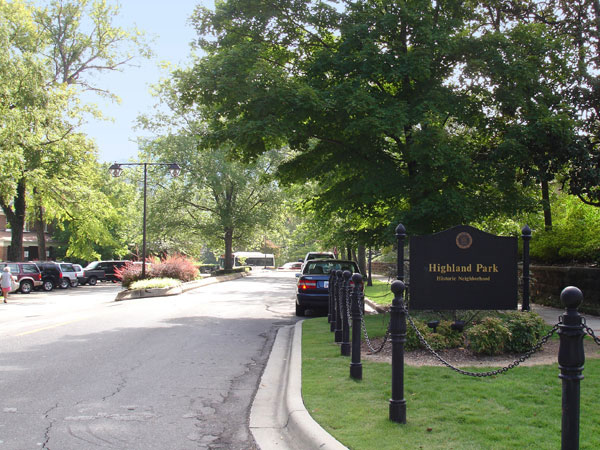Highland Park: Birmingham, Alabama

Summary
Built around swales and ridges at the foot of Red Mountain, picturesque Highland Park continues to attract generation after generation of new residents with its enduring and distinctive public spaces, diversity of uses, proximity to downtown, University of Alabama's Birmingham campus, medical facilities, popular businesses, and entertainment districts.
Designated Area
Neighborhood is bordered by U.S. 280 to the east, Highland Golf Club to the west, Clairmont Avenue to the north and, to the south, Niazuma Avenue and 26th Street South.

The major entrance into Highland Park is along the main thoroughfare, Highland Avenue, which has an award-winning landscaped median, original stone walls characteristic of the neighborhood, protective wrought-iron bollards, a tree-lined canopy, and bus lines. Photo courtesy Gresham, Smith & Partners.
Planning Excellence
The State of Alabama's most densely populated neighborhood, Highland Park has long faced development pressures. Weary of battling each proposed development, residents in 2010 built on the rich planning legacy of Highland Park's visionary founders and partnered with planners to craft Jefferson County's first form-based code to will guide future growth and protect community character.
Originally envisioned as a resort area accessible via streetcar, the 240-acre neighborhood became home to prominent Birmingham families. Its central artery, Highland Avenue, was planned and designed by former Birmingham Mayor Henry Caldwell and Willis Milner, an engineer and developer, to follow the contours of the hilly landscape. Development, beginning in 1884, embraced the challenging topography, resulting in a curvilinear street pattern with parks nestled into curves below street level. The streetscape, while reflecting the emerging importance of motorized transportation, welcomed pedestrians and bicyclists.
The neighborhood, itself a local historic district, is a collection of five national historic districts. Some 20 architectural styles, including Queen Anne, American Foursquare, and Prairie, are represented along with more modest Craftsman, bungalow, and ranch houses.
Highland Park's historic multifamily structures reflected the growing popularity of apartment living in the early 20th century. Although just a quarter of the homes are owner-occupied today, the charming yet adaptable neighborhood is recognized for its active and engaged citizens and neighborhood association.

Located on the ground floor of the 10-story Sheraton Apartments along Highland Avenue, neighborhood eatery Rojo, an exercise facility, and a laundromat contribute to this busy area of the neighborhood. Photo courtesy Gresham, Smith & Partners.
Defining Characteristics, Features
Architecture, history
- Impressive assemblage of more than 20 architectural styles popular during first half of the 20th century
- Prairie-style houses, many designed by S. Scott Joy of Wheelock Joy & Wheelock of Birmingham, are hallmark of neighborhood's Hanover Circle Historic District
- Neighborhood supports historic surveys that lead to listing of five separate historic districts on the National Register of Historic Places: Rhodes Park/Highland Avenue (1982), Chestnut Hill (1987), Country Club (2003), Hanover Circle (2003), Milner Heights 2003)
Reliance on Planning
- First conscious effort in Birmingham to utilize picturesque landscape planning and design
- Inappropriate zoning fought at administrative, legislative, judicial levels; 5-1 decision by Alabama Supreme Court in Pollard v. Unus Properties, LLC and City of Birmingham v. Unus Properties, LLC (2004) favors neighborhood desire to retain single-family zoning
- Highland Park named local historic district (2003), allowing it to initiate preservation activities and provide input into city's design review process
- Highland Park Neighborhood Association and Regional Planning Commission of Greater Birmingham develop neighborhood plan (2008-2009)
- City amends zoning map (2010) to incorporate form-based overlay district, contained in neighborhood plan; identifies acceptable range of development fitting historic character
Sense of place
- Featuring a raised landscaped median, Highland Avenue meanders through the neighborhood; city's first example of traffic calming (from the 1970s) with single lanes, widened sidewalks, and bulbouts. Three sets of unique stone steps allowed original residents to reach streetcar line
- Curvilinear street pattern with variously sloped circles and crescents adds charm and visual appeal; tree canopy enhances streetscape
- Scenic views abound; Highland Avenue offers striking vistas of the below street-grade parks. Looking across Rushton Park, the Independent Presbyterian Church rises like a great English cathedral with its beautiful aged stone, stained glass windows
- Popular for weddings, reunions, and birthdays, the three public parks — Caldwell, Rhodes, and Rushton — are social and recreation centers. WPA–era stone walkways and walls complement landscaping and furnishings

Award-winning Rhodes Park, seen hosting the 2010 annual Do Dah Day event, was restored beginning in 1996 with period lights, restored balustrade, and flowerbed. The distinctive topography within the neighborhood has resulted in a curvilinear street pattern with three parks nestled below street level. Photo by Lee Little.
Sustainability
- Land use mix limits commutes, encourages foot traffic, adds to neighborhood vitality; mix occurs vertically and horizontally as apartment buildings host ground-floor retail, restaurants
- Necessities of daily living and amenities within walking distance: shopping, restaurants, theater, churches, professional offices; medical, recreational, and senior facilities
- Variety of housing options promotes neighborhood diversity; purchase prices range from $42,500-$785,000; monthly rent ranges from $400-$2,500. Section 8 apartments, units for low-income and disabled seniors; also a home for women recovering from substance abuse
- Two bus routes serve neighborhood; bicycle racks throughout neighborhood
- Residents planted 2,500 trees and shrubs over 18 years, emphasizing native species; porous pavement used in Caldwell Park renovation to aid water retention (2007)
Active and Engaged Residents
- Residents lead downzoning effort 1999-2000) to protect 50-plus single-family residences
- Highland Park Neighborhood Association (1975) active in planning, zoning, design review, and beautification; organizes tree plantings, clean-ups; installs benches, waste receptacles
- Annual events attract Highland Park and city residents; Caldwell Park hosts Do Dah Day, state's largest single-day event, and Magic City Smooth Jazz Festival. Gumbo Gala held as fundraiser for low-income senior programs; also Halloween block party, spring and fall children's festivals


